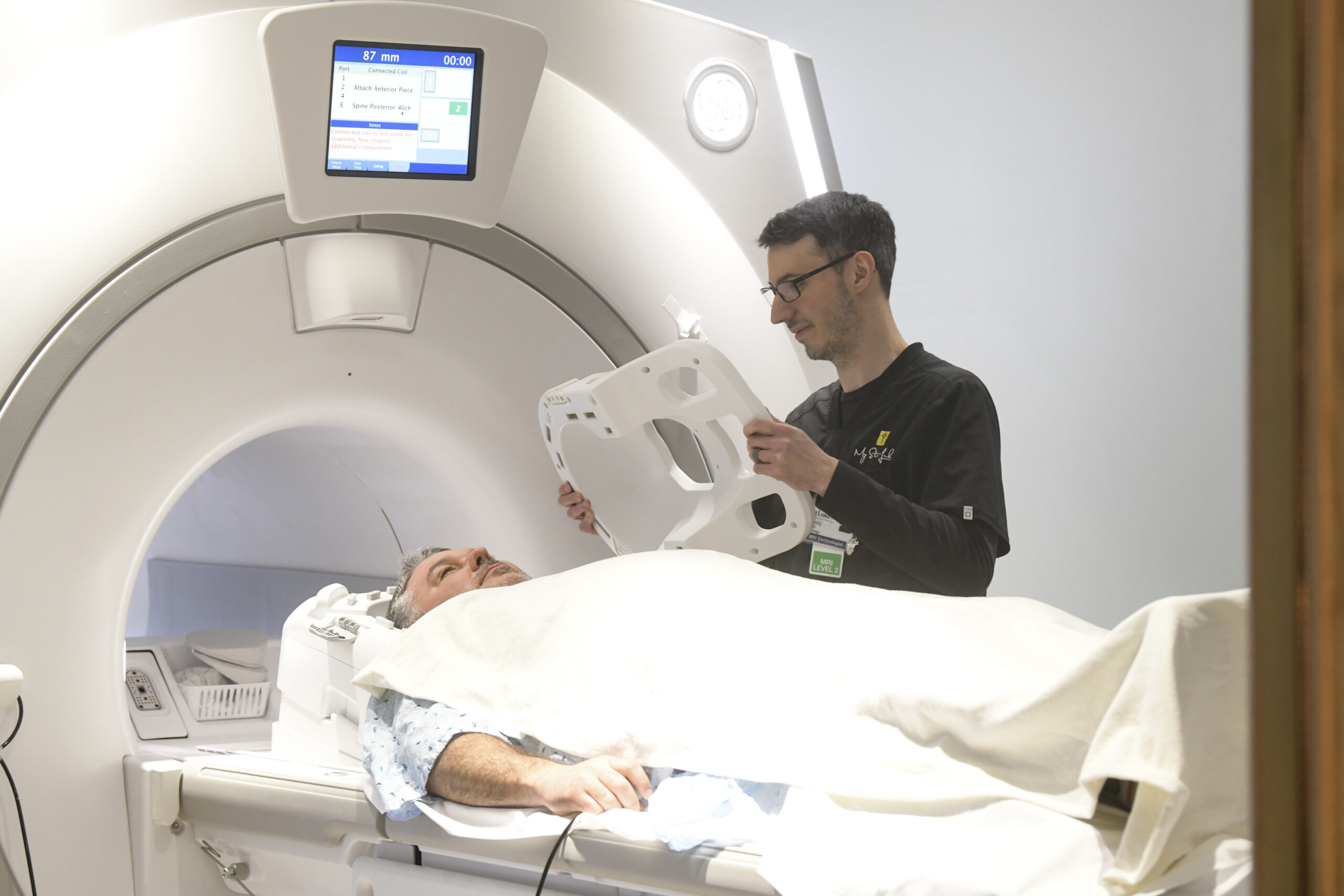Technological advances continuously improve physicians’ ability to evaluate what is happening inside the heart and other parts of the body, enabling them to better diagnose and treat patients. St. Luke’s University Health Network is committed to bringing these latest technologies to its hospitals. Following are examples of technologies St. Luke’s recently added for the treatment of heart and vascular disease.
St. Luke’s Among the First in the Nation To Perform Revolutionary Tricuspid Valve Replacement
St. Luke’s Heart and Vascular team became the first in the region to perform a transcatheter tricuspid valve replacement (TTVR) using the revolutionary Edwards Lifesciences EVOQUE Tricuspid Valve Replacement System.
The EVOQUE system features a self-expanding implant to safely replace a faulty tricuspid valve, offering a minimally invasive solution to eliminate tricuspid valve regurgitation (TR). It helps prevent complications, reduce recovery times, and enhance overall quality of life for those affected by this condition.
The team, led by Jose Amortegui, MD, and interventional cardiologist Christopher Sarnoski, DO, performed the first case on May 20, 2025.
Dr. Amortegui says, “This innovative procedure offers new hope for patients suffering from tricuspid valve regurgitation, significantly improving their quality of life and reducing the risk of severe complications, such as heart failure and atrial fibrillation.”
Heartflow FFR-CT Analysis Can Help Determine if a Person with Suspected Coronary Artery Disease Should Be Treated for Heart Disease
St. Luke’s offers a proven, non-invasive diagnostic option for people with suspected heart disease: Heartflow FFR-CT Analysis. This test may reduce the need for invasive cardiac testing and is offered to hospitals throughout the Network.
A CT scan combined with fractional flow reserve (FFR) measures the ratio of blood flow in a potentially diseased and narrowed coronary artery to blood flow in the same artery when not constricted. AI algorithms then create an anatomical model of a person’s heart that helps physicians visualize the blood flow and detect stenosis, or plaque, that obstructs the blood flow.
“Historically, we have been faced with either using tests that were frequently inaccurate or putting a patient through an invasive procedure just to determine whether they would need another invasive procedure to restore blood flow,” said David Furman, MD, St. Luke’s Medical Director of Computed Tomography. “The Heartflow FFR-CT Analysis completely changes this paradigm, providing essential information that can help us determine the right approach for a patient through a convenient, non-invasive platform.”
Purujit Thacker, MD, St. Luke’s cardiologist with expertise in advanced cardiac imaging, highlighted the benefits of this innovation: “As a cardiologist, my greatest satisfaction comes from preventing heart attacks and other serious cardiovascular events. Heartflow Analysis enhances our ability to detect and address heart conditions before they become critical, ensuring our patients receive the best possible care.”
For patients with symptoms of coronary artery disease, St. Luke’s offers Nuclear Medicine PET Stress Testing, a fast and painless pharmacologic diagnostic test completed in 30 minutes or less. Offered at multiple locations throughout the Network, this fast, painless test checks for calcium in the coronary arteries. The screening CT is $99 and gives a detailed cardiac risk profile.
St. Luke’s Pioneers AI Screening Technology for Early Heart Disorder Diagnosis
St. Luke’s is the first in the Valley to employ advanced artificial intelligence technology, combined with echocardiograms, to detect and monitor potentially serious heart conditions, like aortic stenosis, before symptoms appear.
The Heart and Vascular Center uses the Egnite CardioCare AI digital health platform, which functions with the hospital’s electronic health record (EHR) and echocardiogram images to aid in diagnosing various heart issues in the early stages of development. Echocardiography converts sound waves into images of the heart’s structure, size, and function, including valves and blood flow, to diagnose and monitor heart health and the presence of a cardiac disorder or disease.
The CardioCare AI platform analyzes echocardiograms performed at St. Luke’s in hopes of finding aortic stenosis and other diagnoses so they can be addressed, monitored, or treated in a timely manner.
Stephen Olenchok, DO, Chief of Cardiovascular Surgery, said, “As the region’s leader in heart care innovation, St. Luke’s is pioneering the adoption of the Egnite CardioCare AI platform to expand our clinical toolbox to improve our ability to diagnose, manage and treat a range of developing cardiac disorders in their early stages, with the ultimate goal of improving patients’ quality of life and long-term cardiac health.”
St. Luke’s Invests in AI-Enabled MRI Technology from GE HealthCare
St. Luke’s invested more than $30 million in leading-edge Magnetic Resonance Imaging (MRI) technology and service from GE HealthCare to provide advanced imaging to enhance image quality while reducing scan times and patient discomfort.
St. Luke’s Radiology Chairman Dr. Robert Fournier says, “Medical specialties such as orthopedics, cardiology, and oncology rely on imaging for diagnosis and treatment planning. We are committed to providing the best imaging technology because we understand its vital role in modern medicine.”
These new MRI systems can enhance patient experience by reducing claustrophobia with wider scanners, and they come equipped with Artificial Intelligence (AI), which can significantly improve the quality and speed of MRI scans.
St. Luke’s will be one of the first in the United States to implement Intelligent™ Radiation Therapy (iRT) for MR, a software solution that can improve and accelerate the radiation oncology care pathway with more precise radiation therapy planning and shorter treatment timeline for certain types of cancers.
“In addition to the tremendous advantages this GE HealthCare technology offers our health system,” Dr. Fournier added, “it presents an invaluable educational opportunity for our physicians in residency and fellowship training programs. They’ll gain hands-on experience with the latest AI-driven imaging technology, placing them at the forefront of next-generation medicine and allowing them to witness firsthand how innovation improves patient care and outcomes.”






